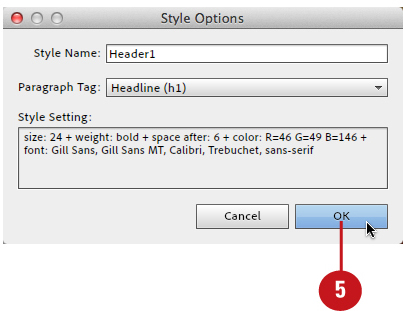8. Working with Character and Paragraph Styles
What You’ll Do
Introduction
Styles enable you to save your favorite combinations of text formatting attributes. You can then apply these attributes to other text objects with a single click. With character styles you can save character attributes, such as font size, style options (bold, italic, underline), text alignment, and text color. With paragraph styles, you can include character attributes as well as paragraph attributes, including leading, paragraph indents, margin spacing, and spacing before and after.
With this chapter, you’ll learn how to save and apply both character styles and paragraph styles. You’ll also learn how to apply formatting overrides to stylized text, as well as how to remove them. In addition, you’ll learn how to redefine styles to include any formatting overrides you’ve applied.
This chapter also explains how to unlink styles from any text objects you’ve applied styles to, and how to utilize space and paragraph tags by applying them via the Style Options dialog box.
Saving a Character Style
Character styles enable you to save your favorite combinations of character formatting attributes, such as character color, style options (bold, italic, and underline), kerning, font, and font size. After you save a character style, you can apply all the saved attributes to a selected text object with a single click of the mouse. You can create a character style by selecting a text object that already has the attributes applied and then clicking the new style button located at the bottom of the Character Styles panel.
Click the Create a New Style from Applied Attributes button
![]() Choose Plan Mode from the View menu.
Choose Plan Mode from the View menu.
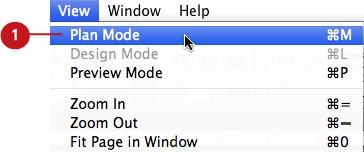
![]() From the sitemap, double-click the thumbnail of a page whose text objects contain attributes you’d like to save as a character style.
From the sitemap, double-click the thumbnail of a page whose text objects contain attributes you’d like to save as a character style.

Muse opens the page in Design Mode.
![]() Click the Text Tool icon at the top of the Design Mode interface.
Click the Text Tool icon at the top of the Design Mode interface.

![]() To display the Character Styles panel, choose Window > Character Styles.
To display the Character Styles panel, choose Window > Character Styles.

Muse does not automatically apply the new character style to the object you created it from. To apply the character style to the object, you must select it and choose the style name from the Character Styles panel.
![]() Click and drag over the formatted text characters with the Text tool cursor.
Click and drag over the formatted text characters with the Text tool cursor.
![]() Click the Create a New Style from Applied Attributes button, located at the bottom of the Character Styles panel.
Click the Create a New Style from Applied Attributes button, located at the bottom of the Character Styles panel.

Muse saves the text attributes currently applied to the selected text object as a character style. By default, Muse names the new style Character Style.
![]() To rename the style, access the contextual menu by right-clicking or Control-clicking (Mac) Character Style in the Character Styles panel and choose Rename Style.
To rename the style, access the contextual menu by right-clicking or Control-clicking (Mac) Character Style in the Character Styles panel and choose Rename Style.

Muse highlights the style name in the Character Styles panel.
Always use the contextual menu to rename or edit character style options. Double-clicking the style name in the Character Styles panel not only opens the Style Options dialog box, but also applies the style to the currently selected text object, which you may not want to do.
![]() Enter a name for the style and press Return (Mac) or Enter (Win).
Enter a name for the style and press Return (Mac) or Enter (Win).

Muse only saves character attributes that are not already applied as part of a paragraph style. If the text object you are basing a character style from already has a paragraph style applied, only those character attributes that are different from the paragraph style are saved as the new character style.
Saving a Paragraph Style
Paragraph styles enable you to save your favorite combinations of character and paragraph formatting attributes. Every character attribute you can save as part of a character style can also be saved as part of a paragraph style. However, paragraph attributes, such as alignment and leading, can only be saved as part of a paragraph style. After you save a paragraph style, you can apply all the saved attributes to a selected text object with a single click of the mouse. You can create a paragraph style by selecting a text object that already has the attributes applied and then clicking the new style button located at the bottom of the Paragraph Styles panel.
Click the Create a New Style from Applied Attributes button
![]() Choose Plan Mode from the View menu.
Choose Plan Mode from the View menu.

![]() From the sitemap, double-click the thumbnail of a page whose text objects contain attributes you’d like to save as a paragraph style.
From the sitemap, double-click the thumbnail of a page whose text objects contain attributes you’d like to save as a paragraph style.
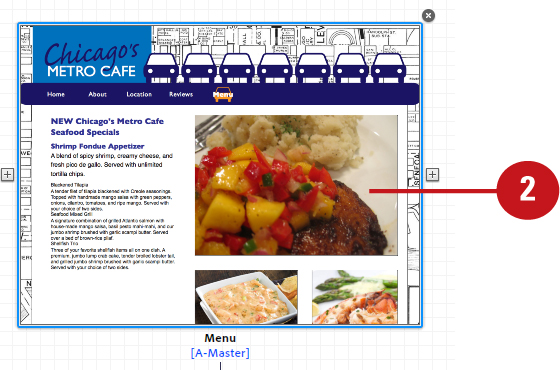
Muse opens the page in Design Mode.
![]() Click the Text Tool icon at the top of the Design Mode interface.
Click the Text Tool icon at the top of the Design Mode interface.

![]() To display the Paragraph Styles panel, choose Window > Paragraph Styles.
To display the Paragraph Styles panel, choose Window > Paragraph Styles.

Muse does not automatically apply the new paragraph style to the object you created it from. To apply the paragraph style to the object, you must select it and choose the style name from the Paragraph Styles panel.
![]() Click and drag over the formatted text characters with the Text tool cursor.
Click and drag over the formatted text characters with the Text tool cursor.
![]() Click the Create a New Style from Applied Attributes button, located at the bottom of the Paragraph Styles panel.
Click the Create a New Style from Applied Attributes button, located at the bottom of the Paragraph Styles panel.

Muse saves the text attributes currently applied to the selected text object as a paragraph style. By default, Muse names the new style Paragraph Style.
![]() To rename the style, access the contextual menu by right-clicking or Control-clicking (Mac) Paragraph Style in the Paragraph Styles panel and choose Rename Style.
To rename the style, access the contextual menu by right-clicking or Control-clicking (Mac) Paragraph Style in the Paragraph Styles panel and choose Rename Style.
Muse highlights the style name in the Paragraph Styles panel.

Always use the contextual menu to rename or edit paragraph style options. Double-clicking the style name in the Paragraph Styles panel not only opens the Style Options dialog box, but also applies the style to the currently selected text object, which you may not want to do.
![]() Enter a name for the style and press Return (Mac) or Enter (Win).
Enter a name for the style and press Return (Mac) or Enter (Win).
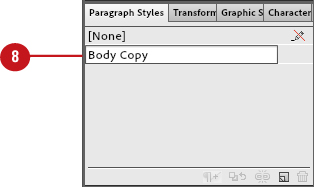
Applying a Character Style
Applying character styles in Muse is just as easy as creating them. After you save your favorite character attributes as a style, you can apply them to a selected text object by clicking the style name in the Character Styles panel. Character styles do not include paragraph formatting attributes, such as leading and alignment. They are best used for stylizing text items such as drop caps or single lines of text that you’d like to stand out from the rest of a paragraph.
Click the style name in the Character Styles panel
![]() Choose Plan Mode from the View menu.
Choose Plan Mode from the View menu.
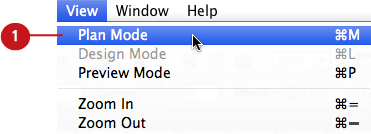
![]() From the sitemap, double-click the thumbnail of a page whose text objects you’d like to apply a character style to.
From the sitemap, double-click the thumbnail of a page whose text objects you’d like to apply a character style to.

Muse opens the page in Design Mode.
![]() Click the Text Tool icon at the top of the Design Mode interface.
Click the Text Tool icon at the top of the Design Mode interface.

![]() To display the Character Styles panel, choose Window > Character Styles.
To display the Character Styles panel, choose Window > Character Styles.

You can apply a character style to a text object that has a paragraph style applied. When you apply a character style to a text object that already has a paragraph style applied, Muse applies the character style definition and does not treat it as a paragraph style override.
![]() Click and drag over the text characters with the Text tool cursor.
Click and drag over the text characters with the Text tool cursor.
![]() Click the style name in the Character Styles panel.
Click the style name in the Character Styles panel.


Muse applies the saved character formatting attributes to the selected text object.
Applying a Paragraph Style
Applying paragraph styles in Muse is essentially the same as applying character styles. After you save your favorite attributes as a style, you can apply them to a selected text object by clicking the style name in the Paragraph Styles panel. Any additional attributes that you apply to a text object after applying the style are considered overrides. You can clear style overrides by Option-(Mac) or Alt-(Win) clicking the style name in the Paragraph Styles panel or by clicking the Clear Overrides button located at the bottom of the panel.
Click the style name in the Paragraph Styles panel
![]() Choose Plan Mode from the View menu.
Choose Plan Mode from the View menu.
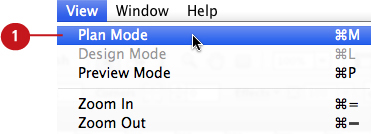
![]() From the sitemap, double-click the thumbnail of a page whose text objects you’d like to apply a paragraph style to.
From the sitemap, double-click the thumbnail of a page whose text objects you’d like to apply a paragraph style to.
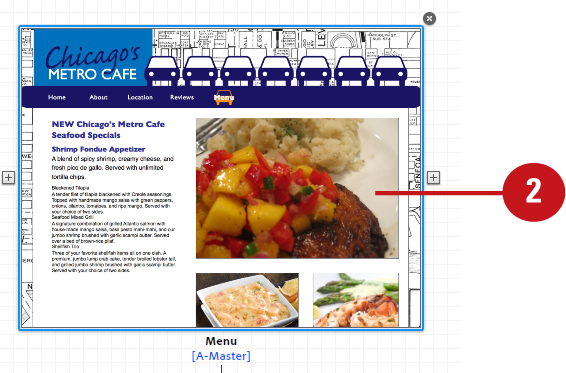
Muse opens the page in Design Mode.
![]() Click the Text Tool icon at the top of the Design Mode interface.
Click the Text Tool icon at the top of the Design Mode interface.

![]() To display the Paragraph Styles panel, choose Window > Paragraph Styles.
To display the Paragraph Styles panel, choose Window > Paragraph Styles.
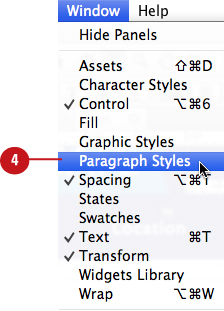
The plus symbol means there is a style override. When you see a plus symbol (+) next to a style name in the Paragraph Styles panel, this indicates that additional attributes—that are not part of the style—have been applied to the object.
![]() Insert the Text tool cursor anywhere in the paragraph you would like to stylize.
Insert the Text tool cursor anywhere in the paragraph you would like to stylize.
![]() Click the style name in the Paragraph Styles panel.
Click the style name in the Paragraph Styles panel.
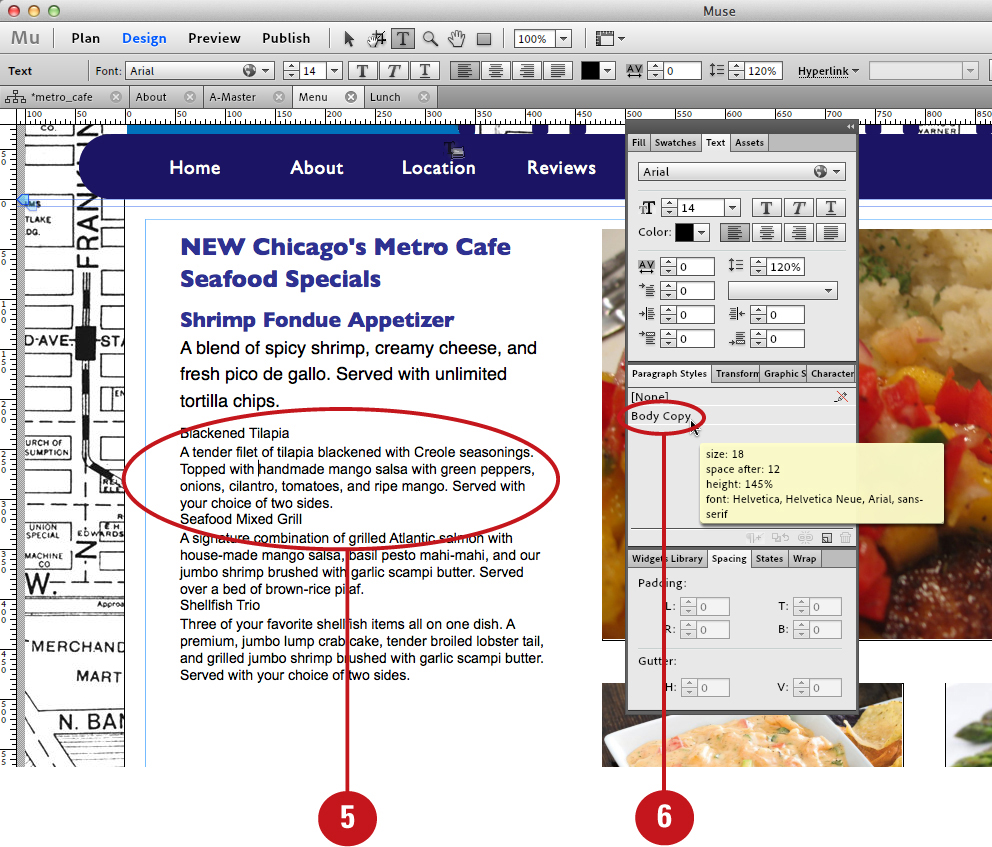
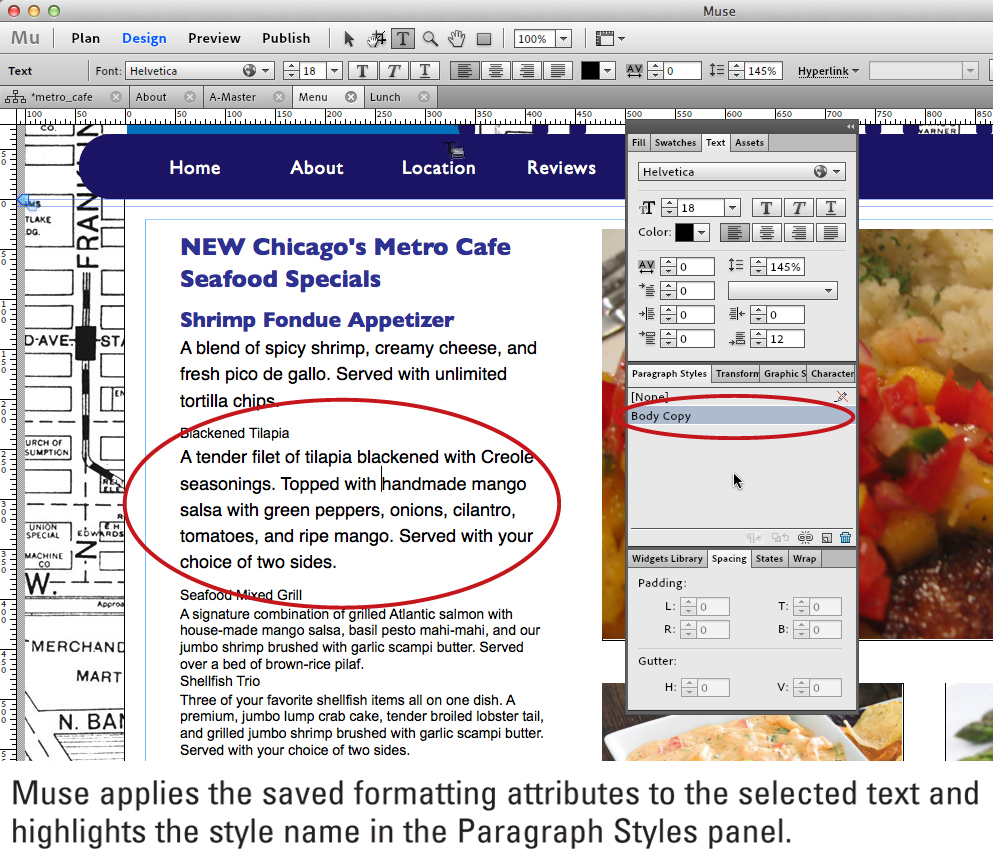
Muse applies the saved formatting attributes to the selected text object.
Applying Style Overrides
When you see a plus symbol (+) displayed next to a style name in the Character Styles or Paragraph Styles panel, this indicates that additional formatting attributes—that are not part of the applied style—have been added to the selected text object. You can apply style overrides by selecting a stylized text object and choosing different text formatting attributes from the Control panel or Text panel.
Add formatting to stylized text
![]() Choose Plan Mode from the View menu.
Choose Plan Mode from the View menu.

![]() From the sitemap, double-click the thumbnail of a page whose text objects contain applied character or paragraph styles.
From the sitemap, double-click the thumbnail of a page whose text objects contain applied character or paragraph styles.
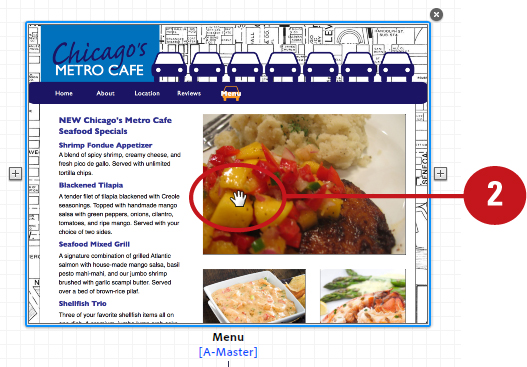
Muse opens the page in Design Mode.
![]() Click the Text Tool icon at the top of the Design Mode interface.
Click the Text Tool icon at the top of the Design Mode interface.

![]() To display the Character Styles or Paragraph Styles panel, choose Window > Character Styles or Window > Paragraph Styles.
To display the Character Styles or Paragraph Styles panel, choose Window > Character Styles or Window > Paragraph Styles.
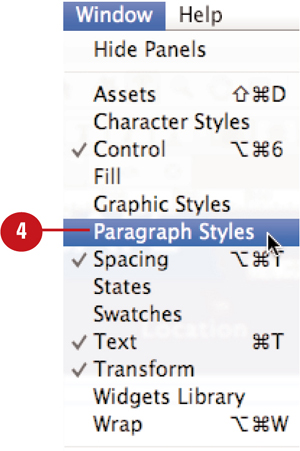
![]() Click and drag over the stylized text characters with the Text tool cursor.
Click and drag over the stylized text characters with the Text tool cursor.
![]() In the Control panel or Text panel, choose the text formatting attributes that you would like to add to the stylized text.
In the Control panel or Text panel, choose the text formatting attributes that you would like to add to the stylized text.

Muse displays a plus symbol (+) next to the style name in the Character Styles or Paragraph Styles panel to indicate that a style override has been applied.
Redefining Styles
The only way to edit a character or paragraph style is to redefine it. You can add any applied overrides to the style definition by selecting the object and clicking the Redefine Style button located at the bottom of the Character Styles or Paragraph Styles panels. Alternatively, you can choose the Redefine Style command from the contextual menu by right-clicking or Control-clicking (Mac) the style name in its respective panel.
Choose the Redefine Style command
![]() Choose Plan Mode from the View menu.
Choose Plan Mode from the View menu.

![]() From the sitemap, double-click the thumbnail of a page whose text objects contain style overrides.
From the sitemap, double-click the thumbnail of a page whose text objects contain style overrides.

Muse opens the page in Design Mode.
![]() Click the Text Tool icon at the top of the Design Mode interface.
Click the Text Tool icon at the top of the Design Mode interface.
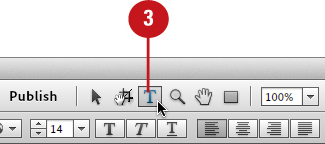
![]() To display the Character Styles or Paragraph Styles panel, choose Window > Character Styles or Window > Paragraph Styles.
To display the Character Styles or Paragraph Styles panel, choose Window > Character Styles or Window > Paragraph Styles.

![]() Insert the Text tool cursor anywhere in the paragraph (paragraph styles) or click and drag over the stylized text characters with the Text tool cursor (character styles).
Insert the Text tool cursor anywhere in the paragraph (paragraph styles) or click and drag over the stylized text characters with the Text tool cursor (character styles).
![]() Access the contextual menu by right-clicking or Control-clicking (Mac) the style name in the Character Styles or Paragraph Styles panel, and choose Redefine Style.
Access the contextual menu by right-clicking or Control-clicking (Mac) the style name in the Character Styles or Paragraph Styles panel, and choose Redefine Style.

Muse redefines the style to include the formatting overrides.
You can also redefine a style by clicking the Redefine Style button. To do so, select the object and click the Redefine Style button located at the bottom of the Character Styles or Paragraph Styles panel.
Clearing Overrides
Any additional attributes that you apply to a text object after applying a style are considered overrides. You can clear style overrides by Option-(Mac) or Alt-(Win) clicking the style name in the Character Styles or Paragraph Styles panel or by clicking the Clear Overrides button located at the bottom of either panel. You can also choose the Clear Overrides command from the contextual menu by right-clicking or Control-clicking (Mac) the style name.
Choose the Clear Overrides command
![]() Choose Plan Mode from the View menu.
Choose Plan Mode from the View menu.

![]() From the sitemap, double-click the thumbnail of a page whose text objects contain style overrides.
From the sitemap, double-click the thumbnail of a page whose text objects contain style overrides.
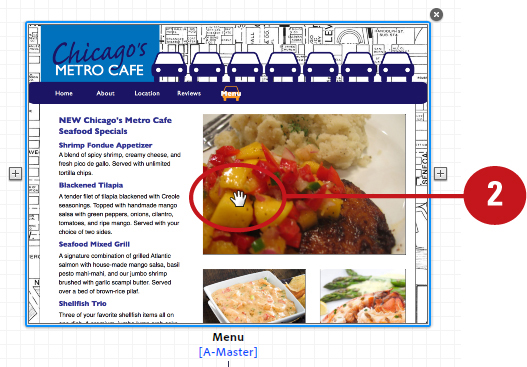
Muse opens the page in Design Mode.
![]() Click the Text Tool icon at the top of the Design Mode interface.
Click the Text Tool icon at the top of the Design Mode interface.

![]() To display the Character Styles or Paragraph Styles panel, choose Window > Character Styles or Window > Paragraph Styles.
To display the Character Styles or Paragraph Styles panel, choose Window > Character Styles or Window > Paragraph Styles.
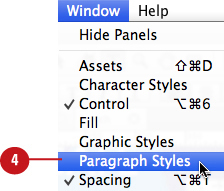
![]() Insert the Text tool cursor anywhere in the paragraph (paragraph styles) or click and drag over the stylized text characters with the Text tool cursor (character styles).
Insert the Text tool cursor anywhere in the paragraph (paragraph styles) or click and drag over the stylized text characters with the Text tool cursor (character styles).
![]() Access the contextual menu by right-clicking or Control-clicking (Mac) the style name in the Character Styles or Paragraph Styles panel, and choose Clear Overrides.
Access the contextual menu by right-clicking or Control-clicking (Mac) the style name in the Character Styles or Paragraph Styles panel, and choose Clear Overrides.
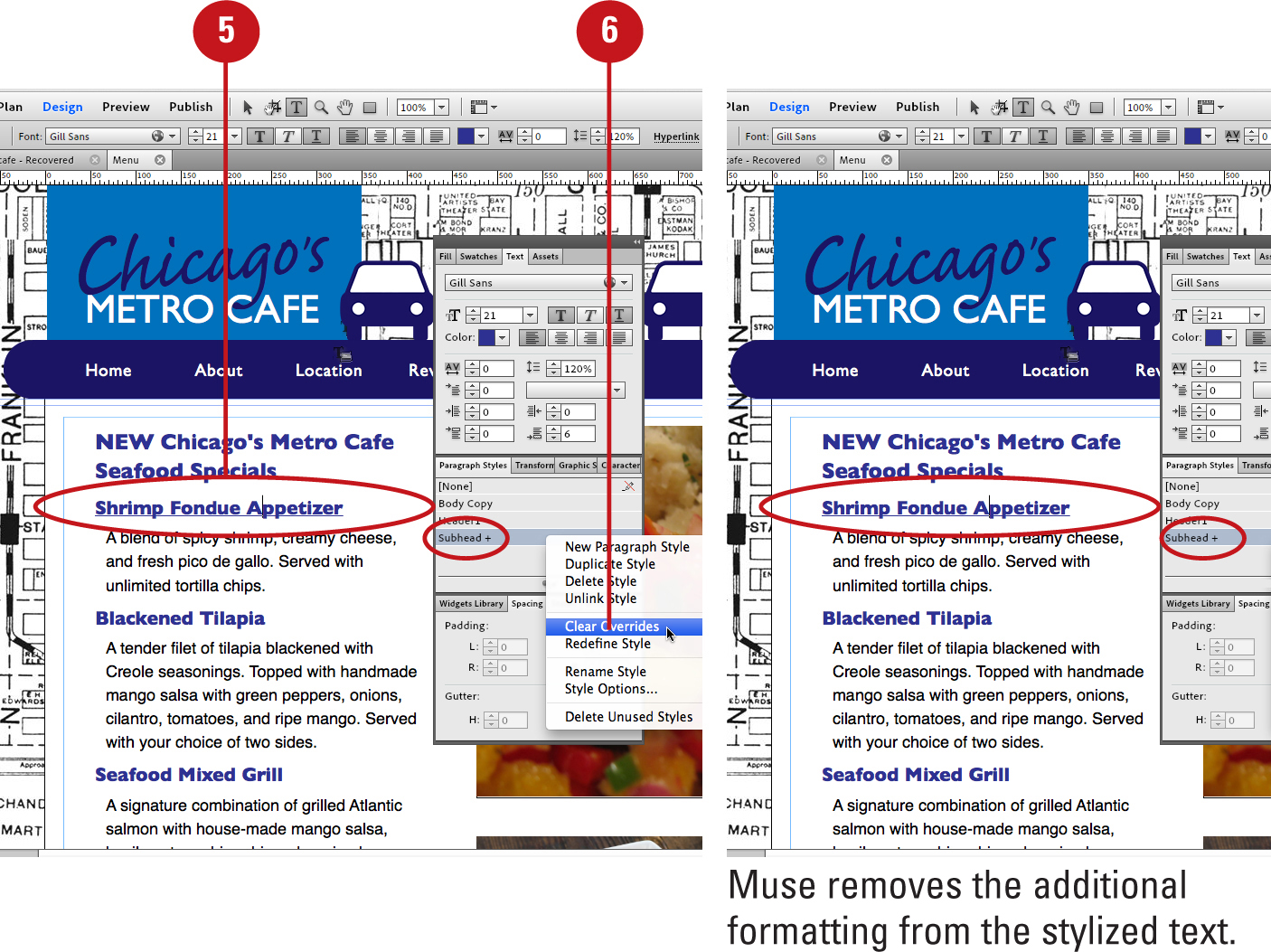
Muse removes the additional formatting from the stylized text.
You can also clear overrides by clicking the Clear Overrides button. To do so, select the object and click the Clear Overrides button located at the bottom of the Character Styles or Paragraph Styles panel.
Unlinking Styles
Unlinking styles removes a character or paragraph style while maintaining the applied text formatting. When you have a stylized text object selected in a layout, Muse highlights the name of the applied style in the Character Styles or Paragraph Styles panel. To unlink the object from the style, click the Unlink style button located at the bottom of either panel. You can also choose the Unlink style command from the contextual menu by right-clicking or Control-clicking (Mac) the style name.
Choose the Unlink Style command
![]() Choose Plan Mode from the View menu.
Choose Plan Mode from the View menu.

![]() From the sitemap, double-click the thumbnail of a page whose text objects contain applied styles.
From the sitemap, double-click the thumbnail of a page whose text objects contain applied styles.

Muse opens the page in Design Mode.
![]() Click the Text Tool icon at the top of the Design Mode interface.
Click the Text Tool icon at the top of the Design Mode interface.

![]() To display the Character Styles or Paragraph Styles panel, choose Window > Character Styles or Window > Paragraph Styles.
To display the Character Styles or Paragraph Styles panel, choose Window > Character Styles or Window > Paragraph Styles.
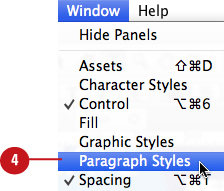
![]() Insert the Text tool cursor anywhere in the paragraph (paragraph styles) or click and drag over the stylized text characters with the Text tool cursor (character styles).
Insert the Text tool cursor anywhere in the paragraph (paragraph styles) or click and drag over the stylized text characters with the Text tool cursor (character styles).
![]() Access the contextual menu by right-clicking or Control-clicking (Mac) the style name in the Character Styles or Paragraph Styles panel, and choose Unlink Style.
Access the contextual menu by right-clicking or Control-clicking (Mac) the style name in the Character Styles or Paragraph Styles panel, and choose Unlink Style.
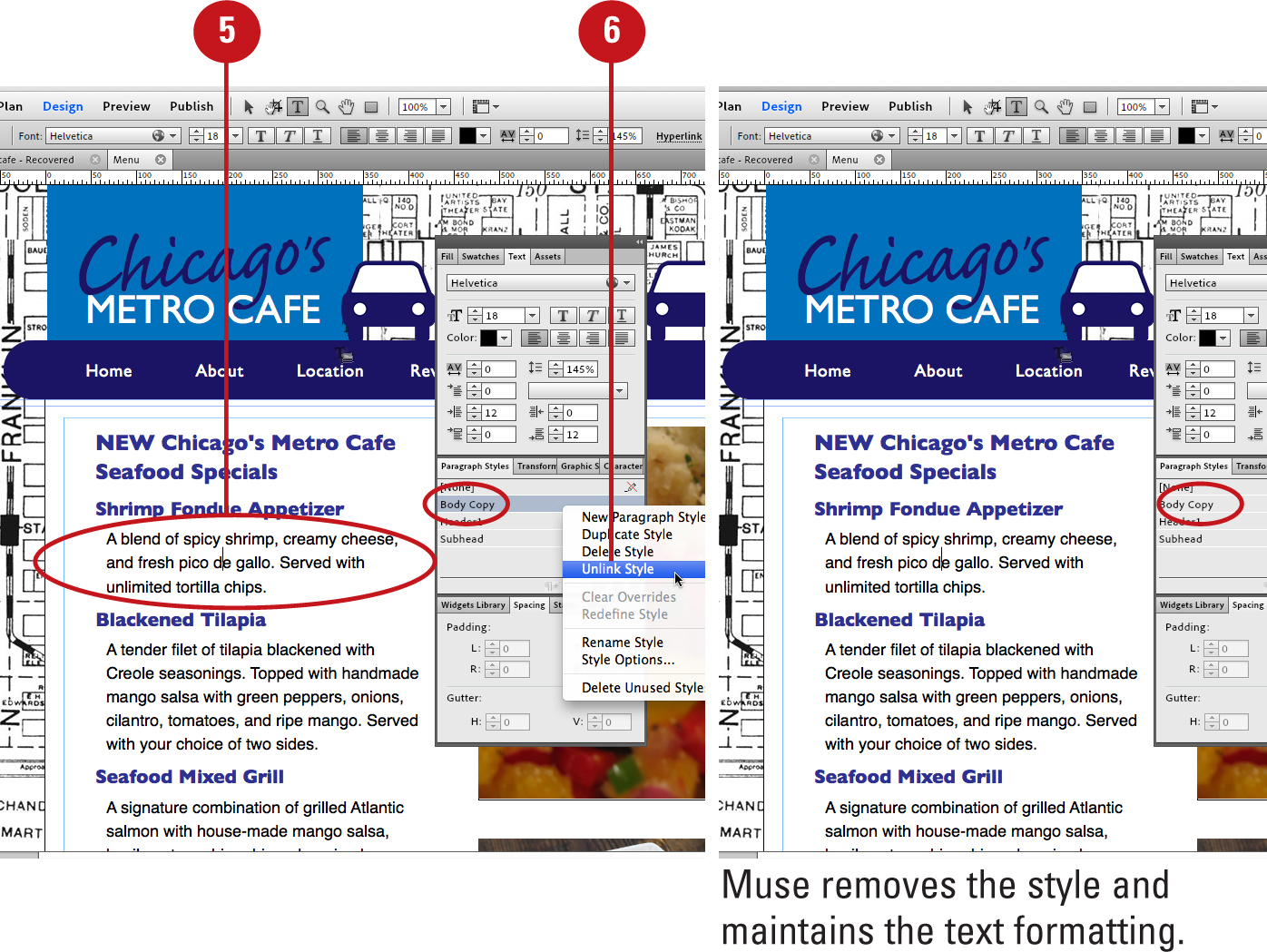
Muse removes the style and maintains the text formatting.
You can also unlink styles by clicking the Unlink Style button. To do so, select the object and click the Unlink Style button located at the bottom of the Character Styles or Paragraph Styles panel.
Deleting Styles
To delete a style from the Character Styles or Paragraph Styles panel, hover the cursor over the style name in the panel and right-click or Control-click (Mac) to access the contextual menu. Choose Delete Style to remove the style from the panel. If the style you are deleting is currently applied to any text objects in the site, Muse asks you what style you would like to use to replace it.
Choose the Delete Style command
![]() Choose Design Mode from the View menu.
Choose Design Mode from the View menu.

Muse opens the current page in Design Mode.
![]() To display the Character Styles or Paragraph Styles panel, choose Window > Character Styles or Window > Paragraph Styles.
To display the Character Styles or Paragraph Styles panel, choose Window > Character Styles or Window > Paragraph Styles.
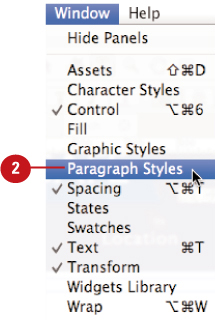
![]() Access the contextual menu by right-clicking or Control-clicking (Mac) the style name in the Character Styles or Paragraph Styles panel, and choose Delete Style.
Access the contextual menu by right-clicking or Control-clicking (Mac) the style name in the Character Styles or Paragraph Styles panel, and choose Delete Style.

If the style is being used anywhere in the site, Muse displays the Replace Style window.
![]() Select a style from the Replace Style list.
Select a style from the Replace Style list.
![]() Click Replace.
Click Replace.
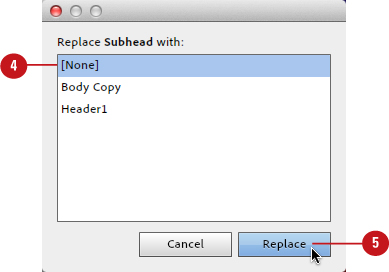
Any text objects that were stylized by the now deleted style assume the attributes of the replacement style.
Applying Style Option Tags
In the Style Options dialog box, you can choose a different span tag to apply to a specific character style, or a different paragraph tag to apply to a paragraph style. Certain span tags, such as (em) for Emphasis, can help with search engine optimization when you export the site. Paragraph tags enable you to specify hierarchical HTML headers to use at site export, such as (h1) for top level headers, (h2) for subheads, and (p) for body copy.
Choose a span tag
![]() Choose Design Mode from the View menu.
Choose Design Mode from the View menu.
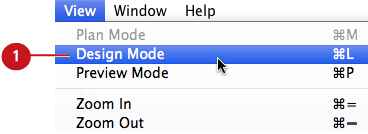
Muse opens the current page in Design Mode.
![]() To display the Character Styles panel, choose Window > Character Styles.
To display the Character Styles panel, choose Window > Character Styles.

![]() Access the contextual menu by right-clicking or Control-clicking (Mac) the style name in the Character Styles panel and choose Style Options.
Access the contextual menu by right-clicking or Control-clicking (Mac) the style name in the Character Styles panel and choose Style Options.

Muse displays the Style Options dialog box.
![]() Choose a new span tag from the Span Tag drop-down list.
Choose a new span tag from the Span Tag drop-down list.
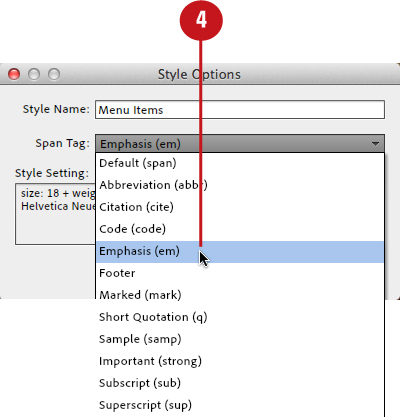
![]() Click OK to close the Style Options dialog box.
Click OK to close the Style Options dialog box.

Choose a paragraph tag
![]() Choose Design Mode from the View menu.
Choose Design Mode from the View menu.
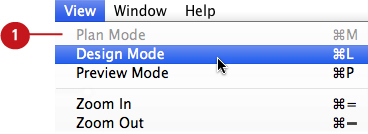
Muse opens the current page in Design Mode.
![]() To display the Paragraph Styles panel, choose Window > Paragraph Styles.
To display the Paragraph Styles panel, choose Window > Paragraph Styles.

![]() Access the contextual menu by right-clicking or Control-clicking (Mac) the style name in the Paragraph Styles panel and choose Style Options.
Access the contextual menu by right-clicking or Control-clicking (Mac) the style name in the Paragraph Styles panel and choose Style Options.
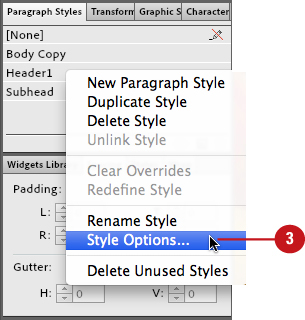
Muse displays the Style Options dialog box.
![]() Choose a new paragraph tag from the Paragraph Tag drop-down list.
Choose a new paragraph tag from the Paragraph Tag drop-down list.
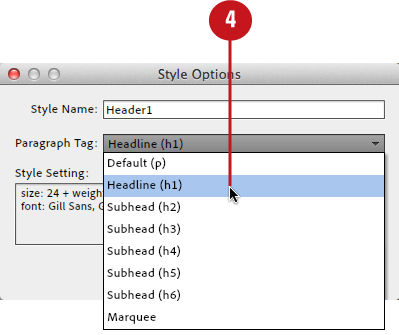
![]() Click OK to close the Style Options dialog box.
Click OK to close the Style Options dialog box.
